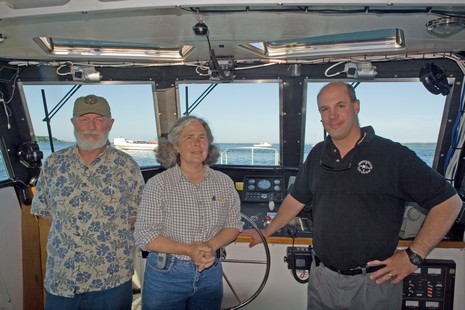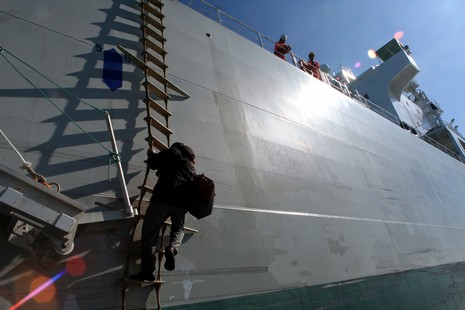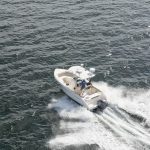Pilot’s bag, part 2 (belated)

Above is a laptop screen from the Wheelhouse II program which is part of the Raven pilot package I discussed back in June when I got a ride on Penobscot Pilot. Skip Strong grabbed the screen from a recording of the Nor’easter outbound trip he piloted that day, and it’s well worth seeing at full resolution. As I wrote in my Sept. PMY column:
Note how, as he {Strong} spun the tanker in the narrow turning basin, the tug’s {Founier Tractor} AIS showed him its precise push vector, and hence what the ship’s bow is doing, while his aft DGPS (the red dot) along with the track ghosts confirm the maneuver’s success. Note, too, the oddly echoed shoreline, the result of the pilots overlaying NOAA’s vector charts with more accurate survey data. Penobscot Pilots even has a weather station mounted on the end of that pier, and another item in Strong’s bag was an experimental wireless receiver for monitoring it in real time during an approach. A big wall of steel can act like a sail, and even with all his other tools, Strong says it’s hard sometimes to know if he’s closing with the pier at 1.2 knots or 0.8 knots. “And it makes a difference.” No doubt!
I’m happy to report that the full column is now online. In it I further note that you can learn some fascinating detail about Strong’s ship (and crew) handling skills because he happens to have been the tanker skipper “who 11 years ago famously came to the rescue of a disabled tug and barge that were drifting fast into Florida’s Gold Coast during a tropical storm.” He later co-wrote a book detailing this amazing story with former Ocean Navigator editor Twain Braden (they alternate chapters, Skip covering what was happening on his tanker and Twain narrating events on the tug and ashore). It’s titled In Peril and it’s great read, definitely worth getting.
Skip also helped me with a Class B AIS article for Professional Mariner (also now online), and I’ve developed quite an appreciation for him and his colleagues in the Pilot association. In fact, quoting myself again, “I rest easier knowing that pilots like Strong shepherd the oil moving around the precious coast of Maine and that captains like {Jane} Ryan bring them home to do it again.” And I thank them both, along mate Harvey Siebert (below left), for showing me their world.














Ben, I’m surprised you have not commented on the container ship hitting the bay bridge in SAn Francisco, spilling thousands of gallons of fuel into the bay. I was reading in the LA times today that the coast guard had asked the pilot to correct his course, and that he replied that the ships instruments said he was on the right heading.
Which begs the question, do other pilots carry their own instruments aboard? Shouldn’t they? In this day and age, pilots set a magnetic course and then forget it? No Radar or GPS?
I mean how in the heck is it possible to hit a fixed object like the bay bridge in this day and age?
1) Possible, sure, … human error. Misread the current prediction, or a land mark your taking a back bearing from, etc.
I am sure these professionals don’t rely entirely on the GPS.
If the GPS does turn out to be at fault, I wonder if they didn’t update their GPS for the new waas satalites ? Lots of people swear that the loss of waas isn’t a big deal, but I have experienced having my position mis-represented by over 100 feet.
2) The coast guard (ashore ?) noticed the potential collision and had time to radio the pilot and have a conversation before the accident. That is impressive.
human error … as reported on msnbc 7 min ago, mechanical failure has been ruled out, and “Investigators were focusing on possible communication problems between the ship’s crew, the pilot guiding the vessel and the Vessel Traffic Service, the Coast Guard station that monitors the bay’s shipping traffic.”
I guess the point I was making, is that it seems that if a pilot relies on the ships instrumentation, that in and of itself would lead to problems.
Ii might be unfamiliar, or setup to display in metric or use a different map datum, or just broken.
I think all pilots ought to have their own, familiar instruments like the one mentioned in this panbo article. I’m curious if it’s ‘normal’ for a pilot to step aboard a ship and expect to know where everything is and how it works.